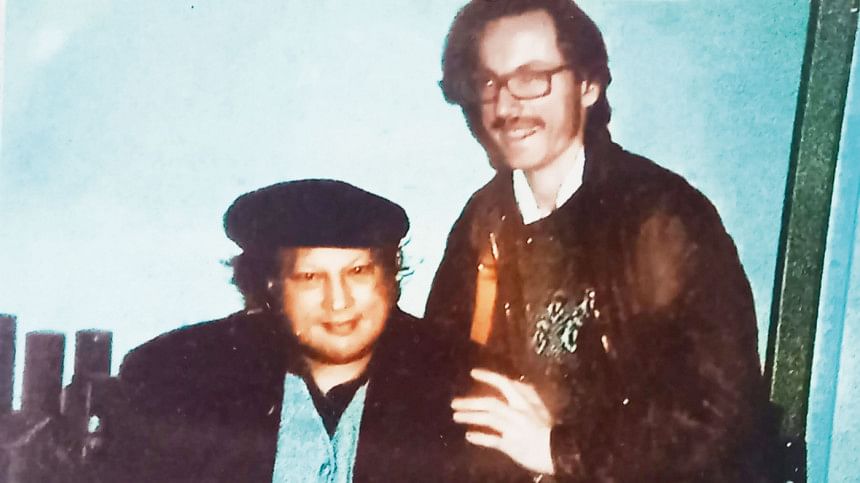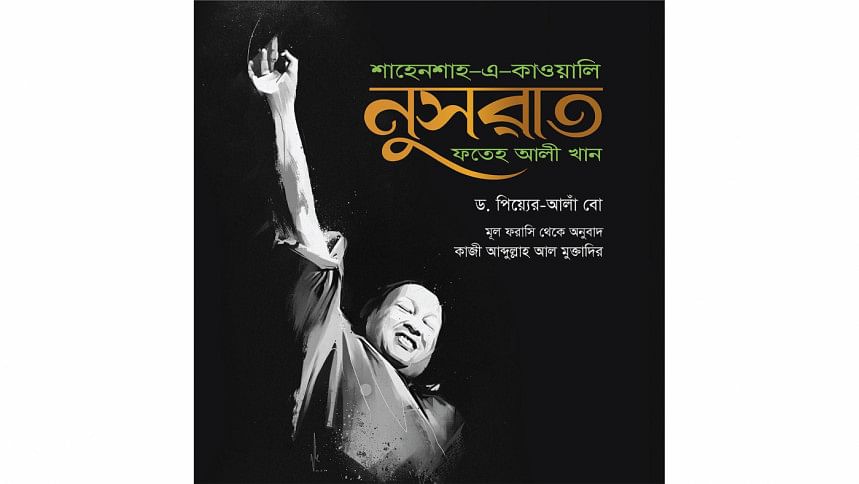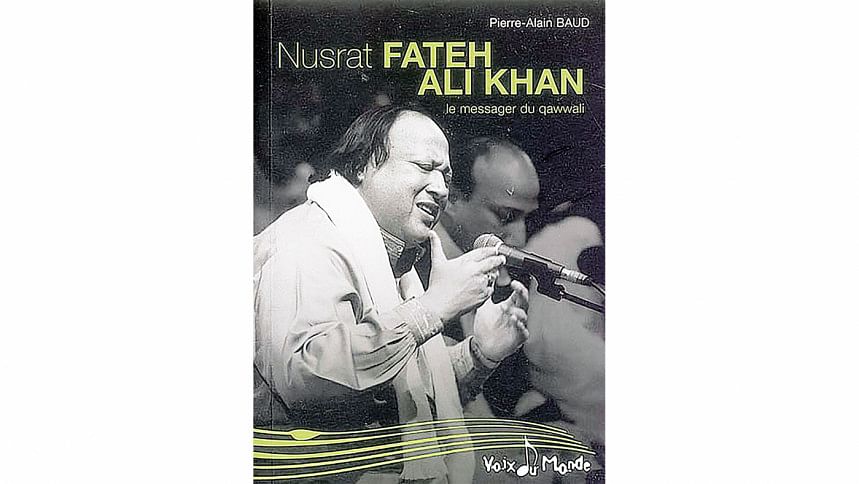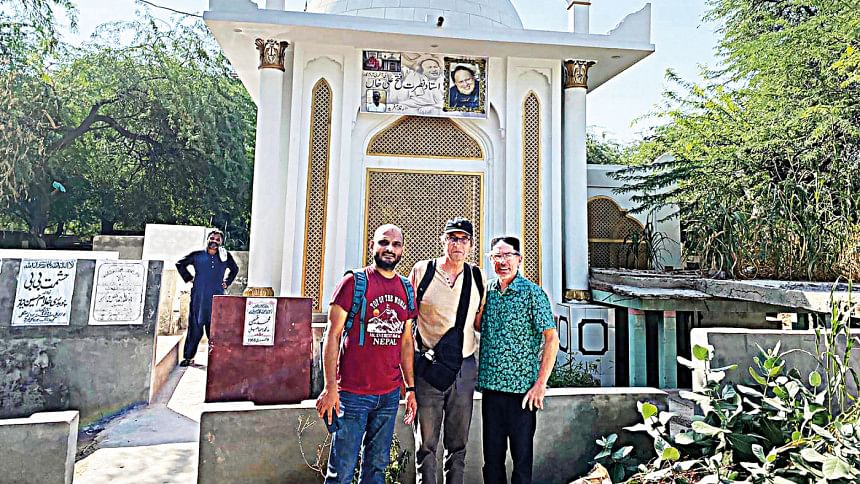With and beyond Nusrat Fateh Ali Khan

Pierre Alain-Baud, (Pyaro), the author of Le Messager du Qawwali (Voix du Monde) (Demi Lune 2008), and Kazi Abdullah Al Muktadir, the book's Bangla translator in Shahen Shah E Qawwali: Nusrat Fateh Ali Khan (Pathak Shamabesh 2022) talked with Nazia Manzoor, Editor of the Daily Star Books. The authors shared anecdotes. What started out as a fun experiment, ended as a lasting experience in the hearts of all of us who were present that day.
PART I
Pyaro Meets Nusrat
On the eve of my PhD departure to Mexico in 1985, I saw posters of Nusrat in the Paris metro. Apart from the fascinating image of his Buddha-like silhouette with an arm rising toward the heavens, a heading caught my attention, 'Sufi music of Pakistan'. At the time I didn't know Sufi music existed in Pakistan, or in the sub-continent. I was equally ignorant about Nusrat.
I travelled to India overland in 1978. I stopped in Istanbul for several days. It was there, I got acquainted with the fascinating dancing whirling dervishes of Konya and the Sufi Saint, Jalal Uddin Rumi. In 1982 or 1983, speechlessly, I witnessed a Qawwali concert of the Sabri brothers in Paris. In June 1985, there was an India Year in France. Indian Qawwals performed on the banks of the Seine River, close to the Eiffel Tower. That was the border of my knowledge of music from the sub-continent at the time.
I got curious. I went to that November 1985 concert. I was mesmerized and enthralled by Nusrat and his Party. I had an astonishing reaction from what was then a predominantly, desi audience.
I bought cassettes. The following day, I was off to Mexico to pursue a PhD in communication and dance as a power issue. That was my first encounter with Nusrat.
I had the good fortune of attending Nusrat's concerts two more times, when he toured Paris in 1988, and in 1991. However, I attended as a mere member of the audience. My chance encounter with the man himself came in 1991 as I mentioned in my book.
The day after his last concert at Théâtre de la Ville, Paris, I found myself at the railway station at Tours on the Saumur platform with a friend. We were going to attend the last couple of programmes of Nusrat for that year in France. These programmes would take place in the old and magical Abbey of Fontevrault.
Nusrat and Party were on the same platform. Fate had it, we were all travelling to the same far-off place. We went to Nusrat's party compartment and introduced ourselves. I need to mention here that Nusrat was not a man of speech. He was a silent person. Most of the time he would engage in musical meditation.
While all the party members were excited to meet fans, crossing over France to follow their tour, Nusrat just said hello and smiled. His presence and aura were enough to make an impression and imprint a mark in my heart.
Nusrat's secretary, popularly known as Iqbal Kasuri, proposed us, 'Aah, you are French! Can you help us sell our cassettes and write about us?' I couldn't have realized at the time that an affirmative and enthusiastic response would take me on a journey into two worlds. One journey would be an on-going personal and spiritual portal with Nusrat and Sufi music. The second and parallel journey would expose me to South-Asian and later to global mystical music audiences, where over time, I've become intricately involved with, professionally and spiritually.
I soon found myself travelling with Nusrat first to Italy. We then went to Pakistan to visit his home in Faisalabad and Lahore. After that, it was everywhere and anywhere if I could make it.
Before I knew, I became the assistant of Mrs. Soudabeh Kia from Théâtre de la Ville in Paris. She was Nusrat's international manager. Mrs. Kia and I became one of the main bridges of Nusrat with a French audience and, later, far beyond the realms of France, all over Europe, the Maghreb, New York, and even Brazil.
In return, I received a priceless enam. Nusrat became my bridge to a world, I would never be able to express in words.
Nusrat had the good fortune to spread the love of Sufism through music to the world. However, he never lost sight of his roots. It was the Dargahs that attracted Nusrat the most. It was here that Nusrat thought he was best serving the Sufis.

First Anecdote: A cup of tea in Muree
Yes, my book lacks anecdotes. Only in the foreword, in pages 1-3, do I appear in the first person. After that I didn't want to expose my egotistic experience with Nusrat. I voluntarily became a fly on the wall trying to describe Nusrat through the eyes of a 'worldly citizen born in Europe', who across the decades, has become more sensitive to the thousand and one fragrances of the subcontinent.
If I start giving anecdotes on Nusrat, I will need to write a book, or at least, significantly adjust the current existing biography. I am seriously thinking about this. For today, let me share two anecdotes. They still shake me when I revisit them.
We were in the hilly station of Murree in the Pakistan Punjab. Nusrat had a public performance at the Municipal Theatre. Just before the concert, while we were doing the usual sound-check, suddenly there was a growing shouting outside against the concert. Some angry people were shouting Haraam. To add to the chaos, a total load shedding occurred. The environment got extremely tense. Everybody started to panic. We decided to disband and meet down the valley.
Our hosts and the party decided that only I and Nusrat's driver would run with him. We would congregate at a small tea stall at the bottom of the valley. When we reached the tea stall, the shopkeeper was startled to see me, a gora. He asked Nusrat: Is he a Musulmaan? Nusrat responded with a smile, not yet.
The chai wallah might still be questioning himself about this curious response. For me, such an open answer meant that according to Nusrat, although I may well be on the right track, I was not yet ready to fully surrender to the One. I still had a long way to go. I took this as a beautiful invitation to a spiritual journey.
The thought of a formal conversion never crossed my mind because of the all-embracing magical power of Sufism and Sufi music that is close to Baul, Hindu, Christian, Buddhist, native Indigenous, and all other mysticism. All is one, as Rumi put it.

Second Anecdote: A musical sponge in São Paulo
Mrs. Soudabeh Kia from Théâtre de la Ville (whom we met in the last anecdote) had planned two different concerts with her Brazilian contacts.
The first concert was to commemorate the tenth anniversary of a prestigious Western classical music held in the mountain resort of Campos do Jordão in the state of São Paulo. That year (1994) the concert was special. For the first time, so called 'world music' artistes would be a part of the event.
The second concert was to take place in a very popular theatre in the center of São Paulo.
Nusrat did what he usually would when he visited a new place for a programme. As soon as he reached the hotel in Campos do Jordão, he switched on the television. He carefully listened to whatever was broadcast, whether it was pop-music, the musical introduction to a programme or even an advertisement.
Nusrat did this to imbibe the soundscape of the place where he would perform. Through this unique alchemy he tried to understand the local nuances of sound. Sound is the basis of all music. And each community has its own way of expressing sound through music. Once Nusrat understood the local sound, he would improvise, colour his traditional qawwali to the local ear. In Brazil that would be the Bossa Nova beat or the Samba rhythm. Elsewhere, it would be rock, rap, bhangra and what not?
On this occasion, however, Nusrat's musical intuition, seemed to have been slightly miscalculated. He, us and the audience could notice. The Brazilian audience at the first concert at Campos do Jordão was mainly of an aristocratic bourgeois background that was predominantly white. Few in the audience were of mixed origin. Their reference frame was more close to western classical music than to Bossa Nova or Samba.
This is my interpretation. I could be wrong. In the end, the public thinned out as the concert progressed. When it ended, the theatre was almost empty and the artistes received very little applause.
Nusrat and the whole party felt disturbed. The return to São Paulo with the prospect of another concert the following day perturbed the mood of the party. It hurt Nusrat the most.
Just before the concert, Nusrat appeared sick and disturbed. We were thinking of canceling this second concert. However, the thousand plus capacity theatre was already overcrowded. It was bursting and bustling in the popular heart and spirit of São Paulo.
Before the concert, Nusrat had a renewed session of listening to the television. With a certain apprehension, the concert started. All of us backstage almost suspended our respirations. A few breaths later we realized that Nusrat was back on track. The second audience was much more in tune with the musical soundscape of Brazil. That concert in the southern hemisphere was a phenomenal success. As usual...
Sound is the basis of all music. And each community has its own way of expressing sound through music. Once Nusrat understood the local sound, he would improvise, colour his traditional qawwali to the local ear. In Brazil that would be the Bossa Nova beat or the Samba rhythm. Elsewhere, it would be rock, rap, bhangra and what not?
Anecdotes of Anecdotes: Why was Nusrat so special?
My close association with Nusrat made me appreciate the fundamental unity of spirituality in all its diversity. This is where and why Nusrat was so special. He was in his earthly time a brilliant embodiment of the One.
Nusrat had the good fortune to spread the love of Sufism through music to the world. However, he never lost sight of his roots. It was the Dargahs that attracted Nusrat the most. It was here that Nusrat thought he was best serving the Sufis. In these sanctuaries, initially through Nusrat, I felt and experienced in its finest ways those thousand and one fragrances of Sufism that has coloured and flowered South Asia for centuries.

Bangladesh becoming a second home
I first visited Bangladesh in 1981 as a volunteer of a small local NGO. Over time, I've interacted with many people and organizations. Let me take this opportunity to mention three of my current interests in Bangladesh.
I've been associated with the Departments of Music, Dance and World Religions and Culture at the University of Dhaka for many years. I'm currently associated with the department's mega three-day event from 11th to 13th July 2024. It is being jointly organized with the International Council for Traditions in Music and Dance, (ICTMD), a UNESCO based NGO through its Music and Affiliated Arts in Greater South Asia (MAAGSA) study group. This is the third international symposium in a series.
Through Arts Nomades (a non-profit research and promotion venture), I am also involved in transcribing first into Bangla, and then later into French and English the minutes of a fascinating three day workshop we held with 35 bauls and affiliated people almost a decade ago on Lalon, Bauler Jibandhara, in the Peace Centre of Unnayan Procheshta NGO, at Rajoir, Madaripur.
A concern close to my heart is to keep on researching, writing, and promoting the Queen of Lalon's songs, our revered Farida Apa, Farida Parveen, as I've been doing worldwide for years. However, that's another story.
PART II
Kazi Abdullah Al Muktadir introduces Nusrat in Bangla
My translation of Pyaro's book, was voluntary and spontaneous. Pyaro handed me the French book one day. I held my breath. A book on Nusrat? As I flicked, I saw a reference to the Bollywood movie, Mughal E Azam. I don't know how many times I've watched the movie. I saw a chapter on the Sufi orders. Although I wasn't educated in the Sufi orders at the time, I identified with it because of a shared history that has run down for centuries.
I told Pyaro, I'll translate the book into Bangla. I felt a personal need to share Nusrat through Pyaro to a Bangla reading audience in Bangladesh where Nusrat is fondly loved and revered.
After translating Pyaro's book on Nusrat from the French to Bangla, I've become enthusiastic to translate another book from the French Pyaro gave me that I think readers in Bangladesh would be interested in. The title of the book is in French and in Bangla, Bengale Doré: Sonar Bangla. It was published by Éditions Ulysse from Paris-Genève in 1972. The publication house no longer exists.
The book was written by François Cochet and Anne-Marie Grobet. It reflects Bangladesh through the eyes of a French speaking Swiss. What makes it special is, one of the authors was a direct and privileged witness to our independence war. He lived in Bangladesh during the entire liberation war. He was a representative of the International Committee of Red Cross, based in the Intercontinental Hotel.
The book starts with a description of this region from prehistoric times. It ends with the birth of Bangladesh. A Bangla translation would add a new flavour to the experience of our independence war through the eyes of a foreigner.
Pierre Alain-Baud is the Artistic Director of Arts Nomades. Email: [email protected]
Kazi Abdullah Al Muktadir is the Administrative Manager at the Embassy of France in Dhaka. Email: [email protected]
Asrar Chowdhury is a Professor of Economics at Jahangirnagar University. Email: [email protected]

 For all latest news, follow The Daily Star's Google News channel.
For all latest news, follow The Daily Star's Google News channel. 



Comments